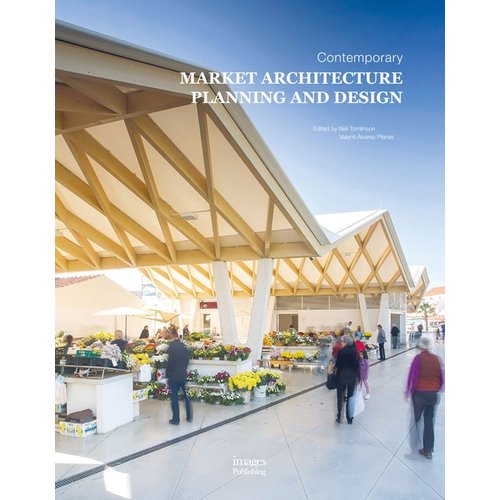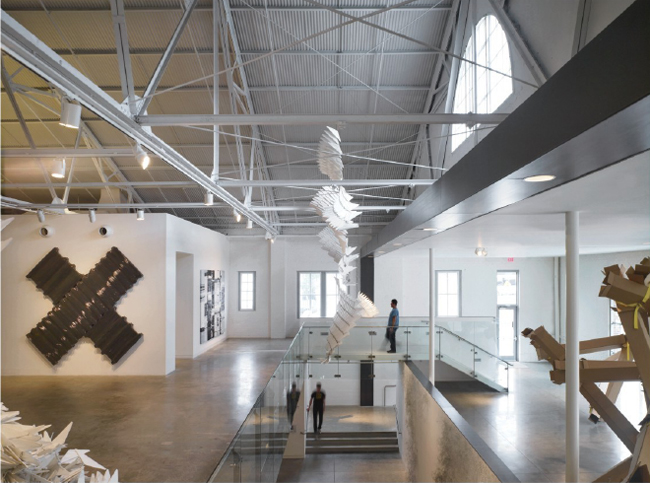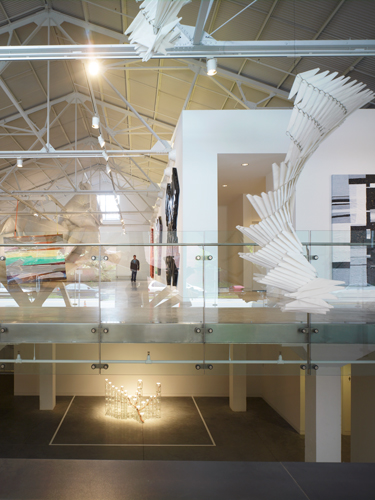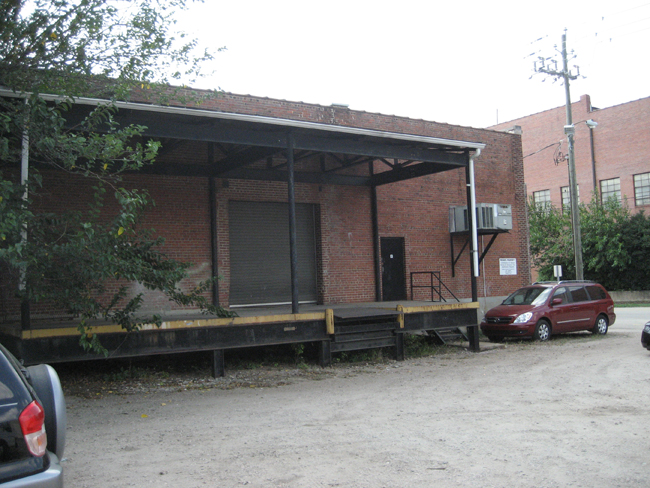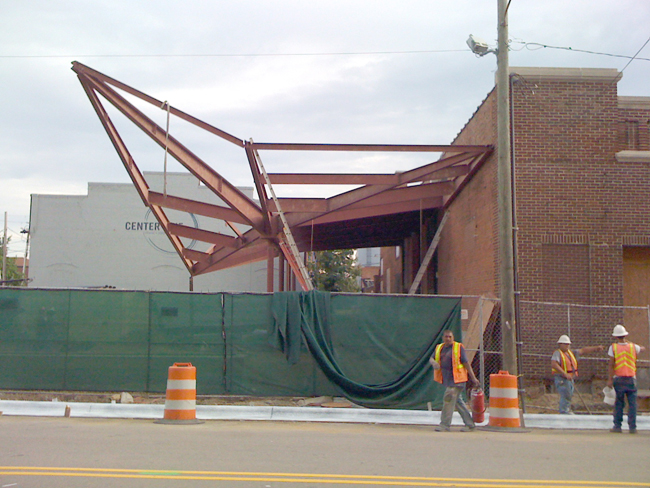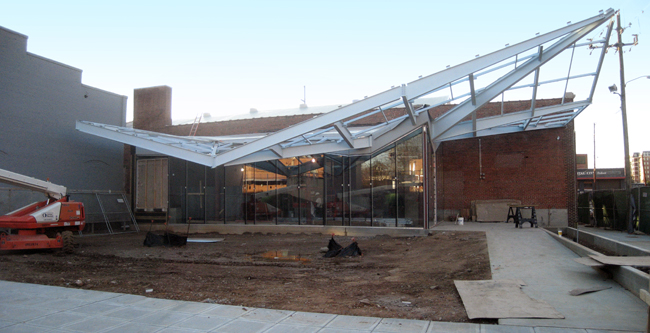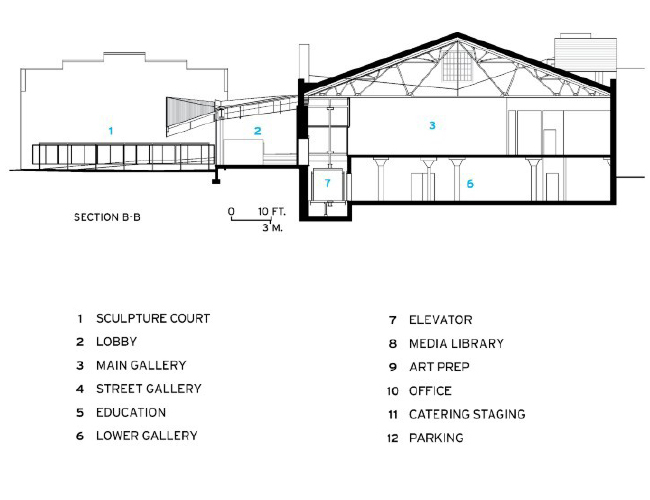Contemporary Art Museum Raleigh
Urban revival Carolina style: Located in a restored produce warehouse, an innovative art center links past and present in an emerging historic district with a promising future.






































Architects & Firms
Raleigh
One of the country's “best” and “fastest-growing” cities (according to Bloomberg BusinessWeek and Forbes), Raleigh has a lot going on in and around its 144 square miles: North Carolina state government facilities, major universities, a vibrant tech industry, and a multifaceted cultural scene. Luckily, a quorum of local officials, professionals, and entrepreneurs strives for an urbanscape that both looks to the future of this small, thriving metropolis and retains its Southern charms.
The city's busy downtown is a hybrid collection of buildings dating from the 18th century to a new convention center and Marriott. Just a block away, the Depot Historic District resonates with the vernacular of its heyday (from the 1880s to the 1950s) as a commercial railroad hub. The four blocks of low-rise brick warehouses, factories, and depots appear to be frozen in time. But stretching out among them, the bold, cantilevered canopy of Raleigh's Contemporary Art Museum (CAM) serves as a vivid affirmation that the neighborhood is moving forward.
A non-collecting museum, CAM Raleigh showcases the work of emerging artists. It is affiliated with North Carolina State University, and hosts educational programs for community schools. So while this museum did not require special climate-control systems, the directors did ask the architects to include space for a learning center and for special events. They also wanted the architecture to echo CAM's innovative agenda.
Designed by the Los Angeles–based Brooks + Scarpa, the recently completed CAM is already an icon in the area, which feels a lot like New York City's SoHo in the 1970s. Extant businesses stand alongside a growing number of galleries, design studios, shops, and watering holes in restored spaces, with some thoughtful mixed-use developments at the periphery of the neighborhood. The city is also building a new light-rail terminal here that will guarantee commuter traffic. Design principal Lawrence Scarpa, whose firm had a small office in Charlotte at one time, picked up on this vibe and developed a scheme that exploits the 21,000-square-foot structure's “good bones.”
The two-story masonry warehouse was built for a blacksmith in 1910, then enlarged slightly by Brogden Produce 15 years later. When CAM purchased the property in 1997, its northern elevation was completely covered with metal panels. Scarpa stripped the facade, restoring the brick and glazing the three bays underneath. Then he cleared the interior, leaving the original steel and masonry intact, and integrating mechanicals and insulation so that the place feels like it might have when it was built. In the first of two significant moves, Scarpa sliced through the thick concrete floor, where a large coal chute once divided the slightly raised main volume from the 1925 street-level addition. This allows a new basement gallery to connect with two open, split-level galleries above, via a steel mesh bridge and stairs. A ramp and new elevator (configured within the old cage) provide universal access to the sub-grade gallery, office, and art preparation room.
In a grand gesture, meant to be as much art as functional device, Scarpa added a 900-square-foot glazed entrance pavilion along the east elevation, creating a sculpture garden out front. Taking his cues from the loading dock it was replacing, he played with the shed roof in plan, folding it into an origami-like plane that dips and sails out from the building and flows into the lobby as a ceiling, for a fluid transition from outdoor to indoor space.
This ethereal tour de force is made of steel beams, painted pale blue to mimic a Southern porch ceiling. The beams support a sheer polycarbonate roof on top and an aluminum insect mesh lined with a whimsical array of powder-coated petals underneath.
“The idea is that you have a building from a period that is heavy and permanent,” says Scarpa. “The [canopy] is light and floating, so there is tension between the two—one representing today and the other yesterday.”
Cost: $3,400,000
Completion date: December 2010
Gross square feet: 22,300
Architect: BROOKS SCARPA/CLEARSCAPES
People
Architect
BROOKS SCARPA (Design Architect)
CLEARSCAPES (Architect of Record)
Personnel in architect's firm who should receive special credit: Architect of record: CLEARSCAPES Interior designer: Brooks + Scarpa
Engineer(s): Mechanical Electrical Plumbing Engineering: The Wooten Company General contractor: CT Wilson Construction
Photographer(s):
CAD system, project management, or other software used: |
Products
Structural system
Manufacturer of any structural components unique to this project:
Exterior cladding Metal Panels: Alum. Perf. Ceiling panels: Accurate Perforating / AlumiWorks Metal/glass curtain wall: Kawneer Moisture barrier: Grace Curtain wall: Custom Storefront: Custom Steel, Inc. w/ CRL fittings Other cladding unique to this project: Fiber Cement Board: James Hardie
Roofing Other: see glazing
Windows
Glazing Insulated-panel or plastic glazing: Polygal polycarbonate panels at Addition roof (exterior) fabricated by Jacob’s Glass Other: Louvers: Pottorff
Doors Metal doors: Ceco Wood doors: Marshfield Sliding doors: Stephenson Millwork
Hardware Closers: LCN Exit devices: Falcon Pulls: Rockwood Manuf. Co. Security devices: Locknetics
Interior finishes Cabinetwork and custom woodwork: Stephenson Millwork Co. / Heavy Metal Welding & Supply Paints and stains: Sherwin Williams Plastic laminate: Nevamar Solid surfacing: Corian Floor and wall tile: Crossville - walls and floors in restrooms Carpet: TANDUS Special interior finishes unique to this project: Glass guardrail/handrail: AlumiWorks with CR Lawrence fittings
Furnishings Reception furniture: Stephenson Millwork and Heavy Metal Welding & Supply Chairs: Knoll Tables: Knoll
Lighting Downlights: Lithonia Task lighting: Bega, Lighting Services Inc.(track lighting), Day-Brite Lighting Exterior: Intense Lighting, BK Lighting, Kim Lighting, Guth Dimming System or other lighting controls: Crestron
Conveyance Accessibility provision: Ramps: Griffin Steel and Supply
Plumbing
Energy Other unique products that contribute to sustainability: Crestron Lighting Management System |



